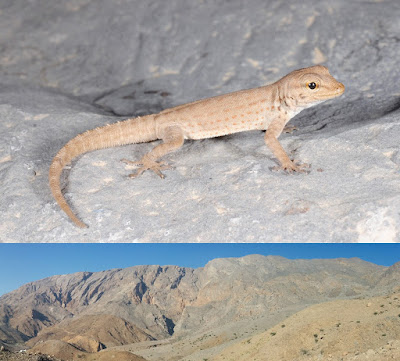[Most Recent Entries] [Calendar View]
Friday, March 3rd, 2017
| Time | Event | ||||||||||||
| 12:02a | [Herpetology • 2017] Diversification in Arid Mountains: Biogeography and Cryptic Diversity of Pristurus rupestris rupestris in Arabia
Abstract Aim To understand the patterns of genetic, geographical and morphological diversification in the Arabian gecko subspecies Pristurus rupestris rupestris, and to discuss the various processes that generate and shape diversity in arid mountain ranges. Location Hajar Mountains, south-eastern Arabian Peninsula. Methods We sampled 466 individuals across the entire range of P. r. rupestris in the Hajar Mountains and sequenced one mitochondrial gene for all the samples, and one extra mitochondrial and four nuclear genes for a subset of 75 specimens. A total of 155 individuals were characterized morphologically. Multilocus coalescent-based methods were used for species delimitation, for phylogenetic inference of species trees and to investigate the diversification dynamics. Multivariate statistics were used to analyse morphological data. Results Our molecular methods revealed 14 candidate species hidden within the subspecies P. r. rupestris. Diversification started c. 15 Ma, but most of the lineages have evolved in the last 7 Ma of the mountains’ orogeny, producing a mosaic of allopatric taxa. Secondary interchange has occurred between high and low elevation lineages, and along the mountain chain between unrelated lineages formerly separated by mountain blocks. Morphological variation between the 14 candidate species is slight, but a high elevation robust morphotype is identified. Main conclusions Our results support the notion that mountain ranges constitute important centres of diversification in arid regions, and also act as ‘species pumps’ into surrounding areas. We also demonstrate that arid mountains may constitute important reservoirs of cryptic diversity, even in common and widespread species. This, and previous evidence, suggest that the Hajar Mountains are a biological hotspot and an important reservoir of diversity. We therefore suggest that these mountains should be a priority focal point for conservation in Arabia. Keywords: allopatry; Arabia; arid mountains; biodiversity; biogeography; cryptic species; diversification; evolution; systematics
Joan Garcia-Porta, Marc Simó-Riudalbas, Michael Robinson and Salvador Carranza. 2017. Diversification in Arid Mountains: Biogeography and Cryptic Diversity of Pristurus rupestris rupestris in Arabia. Journal of Biogeography. DOI: 10.1111/jbi.12929 The Hidden Biodiversity of Reptiles https://www.ibe.upf-csic.es/home/-/asset Scientists uncover 14 new gecko species within a single subspecies - Oman http://www.muscatdaily.com/Archive/Oman/S | ||||||||||||
| 12:06a | [Ichthyology • 2017] Aspidoras mephisto • The First Troglobitic Callichthyidae (Teleostei: Siluriformes) from South America
Abstract Aspidoras mephisto n. sp. is described from the Anésio-Russão cave system, upper Tocantins River basin, Goiás, Brazil. The species can be readily distinguished from its congeners by troglomorphic features and also by presenting the following combination of features: infraorbital 1 generally with well-developed ventral laminar; or moderately developed; poorly-developed serrations on posterior margin of pectoral spine; nuchal plate not externally visible; dorsal fin, even in conspicuously colored specimens, with only dark brown or black chromatophores concentrated on rays, forming spots in some specimens; membranes hyaline; or sparse dark brown or black chromatophores on membranes, not forming any conspicuous pattern; and inner laminar expansion of infraorbital 1 moderately developed. Information about its habitat, ecology, behaviour and conservation status are provided and also a brief description of the juvenile stage.
Geographical distribution: The new species is known only from the Anésio-Russão cave system (Anésio III and Russão II caves), part of the upper rio Tocantins basin (Fig 11). Etymology: The epithet “mephisto” refers to the shortened name of Mephistopheles, demon from the German folklore. Mephistopheles comes from the Greek by the combination of three words: με (me), a negation, φῶς (phōs), meaning light, and φιλις (philis), meaning loving, literally “not-light-loving”, or the one who does not love the light, making allusion to the subterranean behavior of the new species. A noun in apposition. Habitat, ecological and behavioral notes: Aspidoras mephisto shows preference to slow waters (small values of dissolved oxygen), small depths (ca. 0.05 m) and bottom formed by silt, clay and boulders, showing higher values of Total Dissolved Solutes compared to the epigean drainage. Its abundance is relatively high compared to other troglobitic fishes (ca. 50 individuals in pools), and population densities of 5–6 inds.m-2. Juvenile individuals were observed along small stretches of the drainage, always in lentic and shallow places, isolated from the adults and frequently under roots (Fig 2C). Aspidoras mephisto forages calmly close to small submersed roots and silty-bottom (Fig 12A and 12B). They use the anterior extremity of the snout exploring the substrate in a parallel position or forming an angle of ca. 60° in relation to the bottom (Fig 12B), sometimes under the small roots (Fig 12C and 12D). The fish showed this behavior throughout the entire observation time (ca. 20 min) and did not show escape and/or avoidance behavior due to lamp-light or other external disturbances (such as the presence of the observer). Luiz Fernando Caserta Tencatt and Maria Elina Bichuette. 2017. Aspidoras mephisto, New Species: The First Troglobitic Callichthyidae (Teleostei: Siluriformes) from South America. PLoS ONE. 12(3): e0171309. DOI: 10.1371/journal.pone.0171309 |
| << Previous Day |
2017/03/03 [Calendar] |
Next Day >> |



